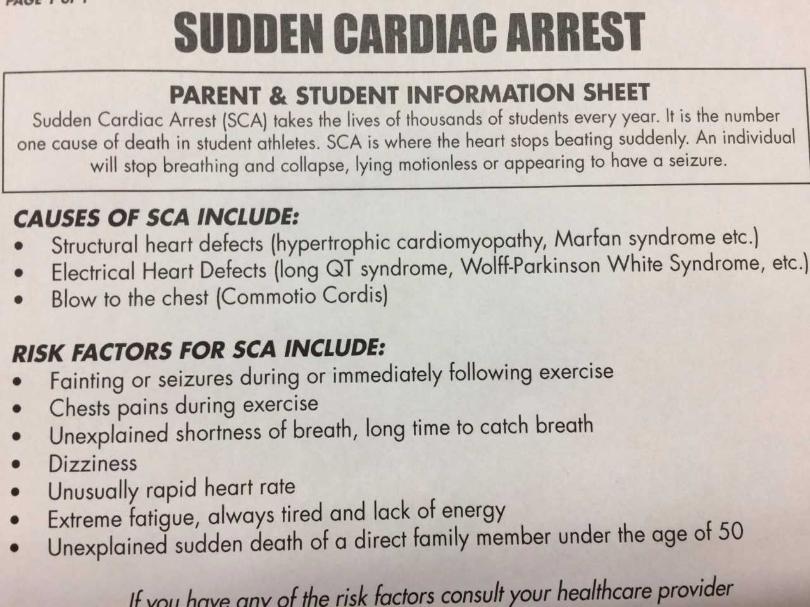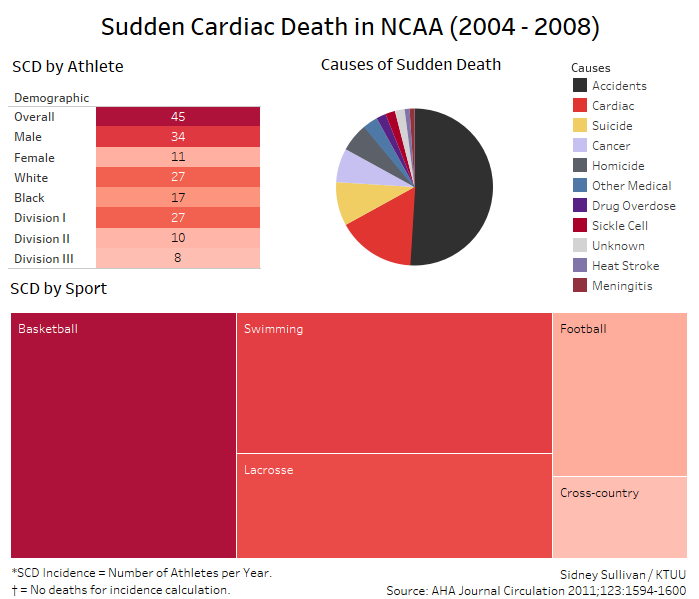New Resource For Student Athletes About Sudden Cardiac Arrest


Methodology:
Data is sourced from the article Incidence of Sudden Cardiac Death in National Collegiate Athletic Association Athletes, by Kimberly G. Harmon, Irfan M. Asif, David Klossner, and Jonathan A. Drezner. The article appeared in Circulation – Volume 123, Issue 15 – on April 19, 2011. Circulation is an AHA Journal.
From January 2004 through December 2008, the researchers examined all cases of sudden death in National Collegiate Athletic Association (NCAA) student-athletes, using an NCAA database. According to the study, the database entailed "weekly systematic search of public media reports and catastrophic insurance claims."
According to the researchers, approximately 400,000 NCAA student-athletes compete "in any given year." And they are typically between 17 to 23 years old, on average.
Over the course of the five years, the researchers determined that 273 student-athletes, among 1,969,663 athlete participant-years, died suddenly. Of these deaths, sudden cardiac death (SCD) was the second leading cause of death, at 45 student-athlete deaths, behind "accidents." This means, between 2004 through 2008, SCD made up 16 percent of all NCAA sudden student-athlete deaths; moreover, the researchers claimed it made up 56 percent of all 80 medical cases.
View the interactive data visualization, above, to:
- Compare the causes of NCAA sudden student-athlete death, between 2004 - 2008.
- Compare SCD by athlete demographic data.
- And compare SCD by the five NCAA sports athletes were most likely to experience SCD: basketball, cross-country, football, lacrosse and swimming.
Story:
It's an effort to warn Alaskans about the risks of Sudden Cardiac Arrest, known as "SCA."
The Alaska School Activities Association is now calling for students and their parents to be notified about SCA, before they participate in athletic activities.
It's a policy change ASAA made to go into effect this year, because SCA is now the number one killer of student athletes.
Billy Strickland, executive director for ASAA, said the requirement is for students and parents to have written information about the deadly killer annually.
"It's often brought on by exercise, so we feel like we have an at risk population we need to get that information out to," Strickland said. "Often times before the event that's catastrophic occurs, there are certain warning signs that are often ignored just because people don't understand them."
The Sudden Cardiac Arrest form includes the causes, risk factors and what to do to increase the chances of survival.
Taylor Carter, a sophomore at Dimond High School, said the information she learned could be valuable beyond school.
"There's sports and activities outside of school that like this could happen, and people need to know about it, because if if you don't know about it, you don't know what's going on," Carter said. "And if you don't know what's going on, you don't know what to do."
Carter said given what she knows now, she'd be more inclined to help someone showing the symptoms.
"Now that I know the symptoms and what to do, it's a little more easier [sic] to identify whats going on," Carter said.
While there are inherent risks to just about every activity, ASAA said the sooner everyone knows what to watch for, the higher the likelihood someone experiencing SCA will survive.
Dr. Stephen Baker, with Full Spectrum Pediatrics, said having more information could help.
"It's a good reminder to talk to your physician – if maybe there are some risk factors in your family based on the symptoms the child is having – and it may warrant an EKG. And that's a new recommendation coming out of the American Academy of Pediatrics," Dr. Baker said.
The form to be signed by students and their parents isn't the only way to help. ASAA said coaches need to be in the game, too.
"Accompanying that we're also requiring our coaches to have training in the signs of sudden cardiac arrest, and what to do if they were to occur at some of those events in a practice or game setting," Strickland said.
ASAA also strongly recommends that schools develop emergency action plans, including access to automated external defibrillators, within 90 seconds.
Story Credit: http://www.ktuu.com/content/news/Alaska-School-Activities-Association-calls-for-awareness-to-Sudden-Cardiac-Arrest-440640883.html


